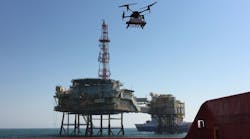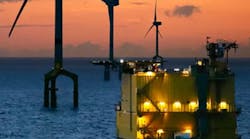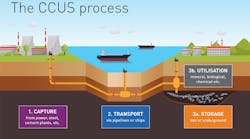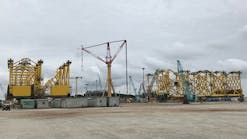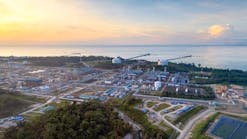By Ariana Hurtado, Editor and Director of Special Reports
HOUSTON — OGCI Climate Investments is a $1 billion-plus independent decarbonization investor that focuses on investing in companies and technologies that can deliver near-term greenhouse-gas (GHG) emissions impact in three areas: reducing methane, reducing CO2 emissions, and recycling or storing CO2.
OGCI Climate Investments boasts that it cost-effectively delivered more than 30 million tons of GHG emissions reduction through 2021 via its 29 different technologies, and more than 3,000 carbon reduction deals have originated since its impact investing began in 2017. Its impact to date has been more than 50 million tons CO2e through 2022.
"Over 95% of the cumulative realized impact to date is economic at current commodity prices without a price on carbon, illustrating the cost-effectiveness of CI’s portfolio solutions," the group states on its website.
David Horsup, managing director with OGCI Climate Investments, led the "Decarbonization of Oil and Gas Operations – Myth or Reality?" Executive Dialogue session at the Offshore Technology Conference (OTC) this afternoon.
Horsup said OGCI Climate Investments pursues technologies and projects aimed at decarbonizing sectors within the energy, steel, chemicals and transportation industries, among others, that account for the majority of GHG emissions but have historically attracted low capital investment for decarbonization.
Investment strategies
When it comes to strategy, OGCI Climate Investments invests in different areas of emission reduction and recycling. That strategy essentially boils down to one thing: impact.
"Our strategy is actually quite simple," Horsup said. "We focus on the areas that can have the largest impact from a GHG impact perspective. And then we look at those three verticals [reducing methane emissions, reducing CO2 emissions and recycling CO2 emissions]; those are three verticals that we really stick to. That's our strategic investment plan, if you like."
From there, he said his team takes a "deep dive" to identify the following:
1. What are some of the most promising companies and technologies in those particular fields?
2. What impacts are these companies and technologies going to have in the short term?
"These companies will share what they think their impact is going to be," Horsup explained. "And they ramp up to 2030. We look at that very objectively, and we typically discount that quite aggressively. Because I see a lot of startups very optimistic in terms of their impact; we put it down with realism associated with that. And so that really is our focus: what is the impact, and can the impact be realized in a short period of time?"
OGCI Climate Investments implements a four-step stage gating process when deciding which projects it will invest in:
- Gate 1: What's the impact? What's the commercial viability?
- Gate 2: Perform deep technical diligence, commercial diligence and diligence around what the impact is.
- Gate 3: Horsup simply identified this as "the hardest gate to get through."
- Gate 4: Check on the management team, perform background checks, and clear any legal red flags.
Horsup added that his team works through those first two steps "very quickly," usually sorting through Gates 1 and 2, as well as completing a deep thesis around the opportunity, within two weeks.
"So literally from identification to funding could be as quick as four to six weeks, which is very, very fast," he said.
He noted that there are some funds that are looking at 2050 and beyond, but OGCI Climate Investments focuses on the next five to 10 years for material impact.
Horsup also said most of the opportunities arise from networking events like OTC.
The low-hanging fruit
Horsup provided several examples from companies that OGCI Climate Investments has assisted in the past five years, primarily focused on methane emissions, which he deems the "low-hanging fruit of our industry."
"We think emissions are prevalent across the industry—and not just our industry, the oil and gas industry—it's prevalent across many other industries as well, [such as] waste management," Horsup said. "So, first and foremost, you've got to be able to identify where the emissions are coming from... and to quantify the extent of the emissions."
Over the last few years, OGCI Climate Investments has invested in a number of "very promising companies" in this particular space, such as Kairos, SeekOps and GHGSat, which all have technologies capable of measuring emissions at various scales.
"GHGSat, for instance, they have today eight satellites," he said. "They just launched three new ones two weeks ago, and they're launching three more later this year. And they continuously scan the surface of the Earth for major emission sources. So, their resolution is about 100 kilograms per hour; that's typically what they can see. And it's 25 meters by 25 meters square. That's the pixel size. So they've begun to take very large ocean surfaces. And then you have companies like SeekOps, which has very precise and accurate detection sensors."
OGCI Climate Investments has more recently added leak detection and repair to its portfolio, and it has companies that actually go out and repair specific leaks.
"A company called CL Invest actually helps operators to monetize their carbon credits from actually making repairs," he explained. "So, it's actually now become almost like a full-service suite of methane detection and abatement reporting and carbon credits [that the OGCI Climate Investment portfolio includes]. It's quite a comprehensive platform."
He also said the methane platforms have started to gain "tremendous traction" in the last couple of years.
Energy efficiency
Horsup said the oil and gas industry has embraced renewables very quickly, and significant progress has been made (e.g., solar and geothermal) but not in every sector.
"In some of the other areas, it's probably not as fast as it used to be," he added. "The other area, which offers tremendous, tremendous potential, is around energy efficiency. Out of all the energy that is procured by an asset, only 50% of it actually is used for the intended purpose. So 50% of it is wasted. So, there are tremendous opportunities to improve the energy efficiency of operations. And that, to me, is the next low-hanging fruit."
He said he is starting to see some movement in that area, but if there's one thing that he could focus on, it would be energy efficiency.



